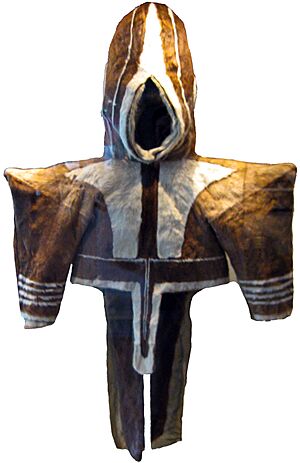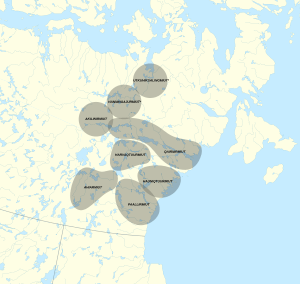Caribou Inuit facts for kids
| Total population | |
|---|---|
| 3,000 | |
| Regions with significant populations | |
| Nunavut | |
| Languages | |
| Inuktitut | |
| Religion | |
| Christianity, Inuit religion | |
| Related ethnic groups | |
| Copper Inuit |
The Caribou Inuit (also called Inuktitut: Kivallirmiut/ᑭᕙᓪᕐᒥᐅᑦ) are a group of Inuit people. They live in Nunavut, a territory in Northern Canada, west of Hudson Bay. They are known for hunting barren-ground caribou. A Danish expedition in the 1920s first called them "Caribou Eskimo". They are the most southern group of the Central Inuit.
Contents
Who are the Caribou Inuit?
The Caribou Inuit are made up of several smaller groups, or "bands." Each band lived in a specific area and had its own way of life, often named after their location.
Main Caribou Inuit Groups
- Ahialmiut: These people hunted caribou all year round. They spent summers near Qamanirjuaq Lake and winters following the caribou herds north.
- Akilinirmiut: They lived near the Thelon River and Akiliniq Hills. Some moved to Aberdeen Lake for better living conditions or education.
- Hanningajurmiut: Known as "the people of the place that lies across," they lived at Garry Lake. Many faced hard times in 1958 when caribou changed their migration paths. The survivors moved to Baker Lake.
- Harvaqtuurmiut: This northern group lived near the Kazan River and other lakes. By the 1980s, most lived in Baker Lake.
- Hauniqtuurmiut: Meaning "dwellers where bones abound," this smaller group lived near the coast. Over time, they joined other groups in Whale Cove and Rankin Inlet.
- Ahiarmiut: These were "people from beyond" or "out-of-the-way dwellers." They lived along the Kazan River and near Ennadai Lake. In the 1950s, many moved to places like Whale Cove and Eskimo Point.
- Paallirmiut: Also called "people of the willow," this was the largest group. They lived south of the Hauniqtuurmiut and Harvaqtuurmiut. Some visited the coast for hunting, while others stayed inland. Today, most live in Arviat.
- Qaernermiut: Meaning "dwellers of the flat land," this northern group lived from the coast to Baker Lake. Most of them now live in Baker Lake.
- Utkuhiksalingmiut: These are "people who have cooking pots." They lived near the Back River and made their cooking pots from local soapstone. Their language is a special kind of Inuktitut.
Where Did They Come From?
Because the Caribou Inuit didn't have a written language long ago, their early history is not fully clear. There are a few ideas about where they came from:
- Some believe they are descendants of an ancient inland culture that spread across the Arctic.
- Another idea is that they came from the Thule people who moved from Alaska.
- A more recent idea suggests they might be related to the Copper Inuit from the Arctic coast in the 1600s. This idea is still being studied.
A Look at Their History
The ancestors of the Caribou Inuit used to travel between the Barrenlands to hunt caribou and Hudson Bay for whaling and fishing in winter. Over time, as caribou populations changed, the Caribou Inuit began to live inland all year. They learned to hunt enough caribou to survive the winters without needing to go to the coast.
Regular contact with European explorers and missionaries began around 1717. This brought new things like guns and introduced them to trapping and whaling. In the late 1800s, an explorer named Joseph Tyrrell estimated there were about 2,000 Caribou Inuit.
In the early 1900s, trade became common, and missionaries arrived. They helped create a written language for the Inuit. Life was often hard, and there were times when food was scarce. In the 1950s, the Canadian government encouraged many Inuit, including the Caribou Inuit, to move from their traditional nomadic life into permanent villages and settlements. This was a big change for them.
Traditional Life and Culture

The Caribou Inuit were nomadic, meaning they moved around a lot. Summers were a time to move to new places for hunting, fishing, and trading. They fished in lakes and rivers. They were strong walkers and sledders, carrying their belongings and tents. They also used kayaks to travel on rivers and lakes, and for hunting caribou when the animals crossed water.
Every part of the caribou was used. Antlers became tools like the ulu (a special knife) and goggles to protect against snow blindness. Hides were used for clothing, including the anorak and amauti (a type of parka for carrying babies). They used caribou sinew (strong fibers) to sew clothes together. Hides were also used for tents and containers.
Caribou Inuit lived in family groups led by the oldest male, called the ihumataq ("group leader"). They believed in animism, which means they thought everything had a soul or spirit. They believed in a female protector named Pinga and a supreme male force called Hila ("air"). Christian missionaries arrived between 1910 and 1930, and most Inuit became Christians, though some still kept parts of their traditional beliefs.
The Caribou Inuit speak the Kivalliq dialect of Inuktitut. This dialect has its own sub-dialects, like Ahiarmiut and Paallirmiut. They also enjoyed nipaquhiit ("games done with sounds or noises"), which included storytelling.
Life Today
New Homes
Moving to coastal communities meant the end of the nomadic life for the Caribou Inuit. They joined the "people of the sea," who were more settled. Adapting to these new towns was challenging, but the government provided some help.
Language Today
Learning English is important, but it also means that the Caribou Inuit's native language, Inuktitut, is at risk of being lost. It's a challenge to keep their language strong.
Art and Creativity
Caribou Inuit are known for their artistic skills, especially for making figurines of animals. A famous artist is Jessie Oonark. They also create string figures (ajaraaq), which are like games and also connected to their beliefs.
Population
Today, about 3,000 Caribou Inuit live in places like Chesterfield Inlet, Rankin Inlet, Whale Cove, Arviat, and Baker Lake.


